#wholesale shawls
Explore tagged Tumblr posts
Text
The Future of Exports: How ValuExim Resources Adapts to Evolving Consumer Demands

In today’s fast-paced world, exports have evolved beyond just moving goods across borders. They’re about delivering a purpose and a promise. Modern consumers seek more than products; they crave connections, stories, and values. At ValuExim, we don’t just adapt to these changing demands; we lead, seamlessly blending tradition with innovation to reshape global trade.
Sustainability: The Heartbeat of Modern Trade
As the world faces environmental challenges, sustainability has grown from a buzzword into a global movement. Consumers now demand products that reflect responsibility toward the planet and its people. At ValuExim, sustainability is at the core of everything we do.
From eco-friendly packaging to ethically sourced materials like camel wool, our operations prioritize the environment and the communities we work with. Take our luxurious camel wool shawls—they’re warm, elegant, and crafted to minimize environmental impact. Similarly, our nutrient-packed makhana is processed with methods that conserve resources while retaining its natural goodness.
Why does this matter? Sustainability isn’t optional anymore—it’s a global expectation. By prioritizing eco-conscious practices, ValuExim stands out in the global market, ensuring every product aligns with these values.
Stories in Every Shipment
In a world driven by experiences, authenticity matters as much as quality. Consumers want products that connect them to a story, a legacy, or a tradition. At ValuExim, every item we export tells a unique tale of India’s rich heritage and the artisans who bring it to life.
Our imitation jewelry sparkles with intricate designs and generations of artistry, reflecting India’s vibrant festivals and traditions. Our dry fruits and nuts symbolize the purity of Indian agriculture, sourced from trusted farms where quality meets care.
Every ValuExim product bridges cultures. Whether it’s a camel wool shawl embodying the resilience of desert communities or a bowl of crunchy makhana that evokes India’s fertile plains, each item is steeped in its origin’s traditions.
Why does this matter? Authenticity is the new luxury. Consumers crave meaningful, unique products, and with ValuExim, they’re not just buying a product—they’re embracing a cultural narrative.
Health is Wealth
As health consciousness grows worldwide, the demand for nutrient-rich, guilt-free foods has soared. At ValuExim, we’ve embraced this wellness revolution with products that are both wholesome and delicious.
Take makhana, for instance. Known as fox nuts, this ancient superfood is gaining global recognition for its high nutritional value and low-calorie content. Whether roasted or spiced, it satisfies cravings while supporting a healthy lifestyle. Our premium dry fruits and nuts—almonds, cashews, pistachios, and raisins—are packed with flavor and nutrition, becoming global kitchen staples.
By prioritizing quality and purity, ValuExim ensures every bite of makhana or handful of dry fruits meets health-conscious consumers’ expectations.
Why does this matter? The health and wellness market is booming, and our products perfectly cater to this growing segment. At ValuExim, we’re not just exporting food—we’re exporting wellness.
Tradition Meets Tomorrow
At ValuExim, innovation and tradition are not opposites—they’re complements. The future of exports belongs to those who honor the past while embracing the present’s possibilities. This philosophy drives everything we do.
Our processes integrate cutting-edge technology with timeless craftsmanship. For instance, while our artisans use traditional techniques to craft camel wool shawls and imitation jewelry, our quality assurance and packaging systems meet the highest international standards. This synergy ensures every product is rooted in India’s cultural legacy and ready for the modern global market.
Why does this matter? Consumers seek products at the intersection of heritage and innovation. By offering exports that honor tradition while aligning with contemporary tastes, ValuExim creates a unique value proposition that resonates globally.
The ValuExim Difference
At ValuExim, we don’t just export products—we export values. Every shipment reflects our commitment to sustainability, authenticity, and innovation. We see ourselves not as traders but as custodians of India’s rich cultural and natural heritage.
Whether it’s the warmth of a camel wool shawl, the sparkle of imitation jewelry, the crunch of makhana, or the richness of dry fruits, every ValuExim product tells a story worth sharing.
Discover the Future of Exports
The world is changing, and so are consumer demands. At ValuExim, we’re proud to lead this transformation, redefining global trade with purpose, provenance, and promise.
Discover the ValuExim difference—where tradition meets innovation and sustainability fuels progress. Join us in crafting a future where Indian artistry shines brighter than ever.
Instagram
LinkedIn
X
#dried fruits wholesalers#dried fruits and nuts#camel wool fabric#camel wool shawl#imitation jewelry
0 notes
Text
Rayon Chenille 1300 Tapestry Cone Yarn

Our rich rayon chenille is dyed in multicolor hues for exquisite, lush palettes that can be combined with our solid #3310 Chenille 1300 or #3311 Chenille 1300 Deluxe colors. Weave or knit to create a soft, beautiful variegated effect in garments, shawls, or blankets
Yarn Weight: 3 - Light / DK Content: 100% Viscose Yardage: 1,300 ypp Put-Up: Cone Approx. Weight: 1.65 lb Care: Dry Cleaning
To know more about this product visit - https://www.silkcityfibers.com/products/rayon-chenille-1300-tapestry-cone-yarn
#wholesale yarn suppliers usa#silk city fibers#knitting yarn#weaving yarn#world’s finest yarns#blanket yarn#shawls yarn
0 notes
Text
https://www.kashmirstorz.com.
0 notes
Text
Crafting Tradition: Inside the World of Pashmina Shawl Making in India
Pashmina shawls, renowned for their exquisite craftsmanship and luxurious feel, have been an integral part of Indian culture for centuries. Among the various regions known for producing these masterpieces, India stands out as a hub for traditional Pashmina shawl manufacturing. These shawls, made from the fine wool of Pashmina goats, are prized for their softness, warmth, and intricate designs. In this blog post, we'll take you on a journey deep into the heart of India's Pashmina shawl-making industry, exploring the rich tradition and skill that goes into each piece.

To truly appreciate the artistry behind Pashmina shawls, it's important to understand their historical roots. Pashmina wool has been woven into shawls in the Kashmir region of India for centuries, with records dating back to as early as the 3rd century BC. Over time, the craftsmanship of Indian artisans transformed Pashmina shawls into symbols of luxury and prestige, coveted by royalty and fashion enthusiasts alike. Today, Pashmina Shawl Manufacturers in India continue this legacy of excellence, preserving age-old techniques passed down through generations.
Traditional Pashmina Shawl Making Process
Crafting a Pashmina shawl is a meticulous process that requires skill, patience, and attention to detail. It all begins with the careful selection of Pashmina wool, sourced from the underbelly of Himalayan goats. The wool is then cleaned, spun, and dyed using natural extracts to achieve vibrant colors. Skilled artisans meticulously weave the wool into intricate patterns using traditional handlooms, a process that can take weeks or even months to complete. Each step in the process is guided by centuries-old techniques, ensuring that every Pashmina shawl is a masterpiece of craftsmanship.
Challenges and Preservation Efforts
While the demand for Pashmina shawls continues to soar, traditional manufacturers in India face numerous challenges. Competition from mass-produced imitations and the rising cost of raw materials threaten the survival of this ancient craft. However, there is hope on the horizon, as efforts are underway to preserve and promote traditional Pashmina shawl-making techniques. Organizations and artisans are working together to raise awareness about the importance of supporting authentic Pashmina craftsmanship, ensuring that this cherished tradition lives on for future generations.
The Artisans Behind the Craft
At the heart of India's Pashmina shawl-making industry are the skilled artisans whose dedication and talent bring these exquisite creations to life. These artisans, often from generations of weavers, possess a deep understanding of the craft passed down through their families. Their passion for preserving traditional techniques and creating timeless designs is evident in every stitch and weave. By supporting these artisans, we not only invest in the beauty of Pashmina shawls but also in the livelihoods of those who keep this ancient tradition alive.

Modern Innovations and Trends
In today's rapidly evolving world, Pashmina shawl manufacturers in India are embracing modern innovations while staying true to their heritage. Advanced machinery and technology have streamlined certain aspects of the production process, making it more efficient without compromising on quality. Additionally, contemporary design trends are influencing the styles and patterns of Pashmina shawls, catering to the tastes of a new generation of consumers. However, amidst these changes, the essence of traditional craftsmanship remains at the core of every Pashmina shawl produced in India.
Impact on Local Communities
The Pashmina shawl-making industry plays a significant role in the economic and social fabric of many communities in India. In regions like Kashmir, where Pashmina weaving is a way of life, entire families are involved in the production process, from shepherds who raise the goats to artisans who weave the shawls. The industry provides employment opportunities and generates income for countless households, contributing to the socio-economic development of these regions. Furthermore, by preserving traditional crafts and cultural heritage, Pashmina shawl manufacturers in India help foster a sense of identity and pride within local communities.
Conclusion
In conclusion, the world of Pashmina shawl-making in India is a testament to the enduring legacy of craftsmanship and tradition. From the majestic Himalayan mountains to the skilled hands of artisans, every aspect of the process reflects a deep-rooted reverence for the art of weaving. By supporting authentic Pashmina shawl manufacturers in India, we not only embrace the beauty of these exquisite creations but also uphold a timeless tradition that continues to enchant and inspire generations to come.
#Pashmina Shawl Manufacturers in India#wool manufacturers in india#wholesale scarves suppliers india
1 note
·
View note
Text

PHOTOSHOOT: PLASTIK MAGAZINE
Great things always come to those who wait. Just a week into 2025 and Marina surprised us with her first cover shoot for New York/Beirut-based magazine Plastik.
The shoot was lensed by Eli Rezkallah with fashion direction by Bashar Assaf. The insane up-do wig is by Ghastly Wigs which was installed and styled by Hannan Siddique. Makeup by Deborah Altizio.

We're starting off strong with Marina in the most stunning vintage Mugler Spring/Summer 1996 skirt suit in black and white crepe, featuring a large folding collar, statement button, rounded hem and 3/4 sleeves.

Her black stretch over-the-knee boots with pointed toe in black are the Ultrastuart 100mm boots by Stuart Weitzman ($1,935.00).
Shop:
Stuart Weitzman "Ultrastuart" Boots ($1,935.00)

For the second cover, Marina slipped into a total pink spandex look from Richard Quinn's Fall/Winter 2022 show. The difference between the runway version and Marina's is that hers features a crossover neckline and rectangular belt buckle.

The third look, and my absolute favorite one, is just the coolest Marni Fall/Winter 2024 moment. Marina chose the black flocked cotton oversized padded jacket with crayon print all over ($2,580.00).
Shop:
Marni Crayon Jacket ($2,580.00)

Her sunglasses are signed by Marni as well. The Odrius model features a futuristic, oversized rimless lens and wavy arms. M chose the colorway "Chocolat" ($465.00).
Shop:
Marni "Odrius" Sunglasses ($465.00)

I don‘t think these boots need a big introduction ;) Marina finally joins the other girlies in the club of the Kiki boots by Marc Jacobs! Shown here in full black crystal look ($695.00).
Shop:
Marc Jacobs "Kiki" Crystal Boots ($695.00)

Standing in the midst of the big apple, our girl wears a vintage Vivienne Westwood red wool jacket with downward peak hemline, shawl lapel and puffed shoulders (similar pictured). She matched it with the mini denim skirt with solarised folds ($262.00) from Diesel, a label new to her!
Shop:
Diesel Denim Mini Skirt ($262.00)

M crowned her look with this avant-garde red headpiece designed by Ellen Christine Couture which was sourced from vintage fashion mekka New York Vintage.

For the penultimate look, Marina is seen holding the world while wearing a custom-made spandex hooded catsuit with this immaculate Matthew Campbell Laurenza hand-sculpted gold-plated brass costume bra with cubic zirconia crystals (€1,820.95).
Shop:
Matthew Campbell Laurenza Jeweled Bra (€1,820.95)

To my knowledge, this is the first time we’ve seen Marina in a Carolina Herrera design, and she truly couldn’t have chosen a better piece for her debut.
She's wearing the Fall/Winter 2024 silk-faille ruffle-embellished skinny pants in black crepe ($995.00 - sold out).
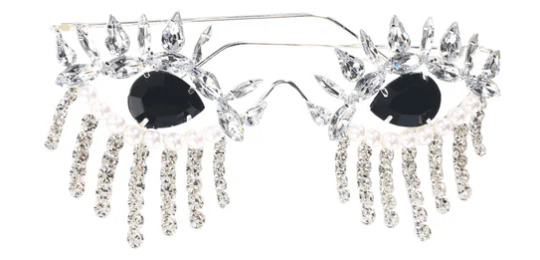
M also wears these surrealistic Evil Eye rhinesrone fringe and pearl glasses. These bear no label and are actually available via various wholesale retailers!
#January 2025#Mugler#Diesel#Skirts#Vivienne Westwood#Jackets#Marni#Eyewear#Matthew Campbell Laurenza#Richard Quinn#Tops#Carolina Herrera#Pants#Ellen Christine Couture#New York Vintage#Hats#Marc Jacobs#Stuart Weitzman#Boots
9 notes
·
View notes
Note
what are your go-to resources for phantom blood fashion historical accuracy...... ...
ok I'm glad you asked this because I've been writing up a whole other post on dio's fashion sense and i wasn't sure how much of the period's fashion trends to explain since I didn't want to make an assumption that nobody knows anything about late victorian fashion. this will be a good reference post for me...and you... and anyone else who wants to use it.
regardless; I hate to say it but the best way to start drawing period clothing is to do a little reading on the fundamentals of [late] victorian dress because it will seriously assist you in the long run, e.g., you won't have to scratch your head and spend time wondering why you keep coming across two different lapel types on tailcoat fashion plates if you're aware that both peak tips and shawl collars were in vogue in the late 1880s and the '90s.
I'll put some basic information that I've collected for myself here so you don't have to go looking for it; I'm going to write this assuming you're a newborn baby deer poking your nose into the victorian era for the first time in your life fully unaware of the customs.
reference links for the wayfarer so you don't have to scroll all the way to the bottom:
Etiquette books. Look for anything written in the 80s/90s; again, period trends change. There's usually always a section on how men should be dressing on different occasions (weddings, funerals, daily casual travel, etc.) in these. In an ideal world one would only have to reference books written/published in London, however I've found that there are many more from US. This is fine though IMO, there was a lot of cross-talk between countries due to the implementation of the telegraph and hence a lot of etiquette standards are "universal" (it's why fashion between EU/US/AU can look pretty similar at the same time--they were all talking to each other). If there's a difference between the "New York" way of doing things and the "London" way of doing things, the authors usually point this out. kind of funny. I love reading these, they're also very good for understanding the general quirks of late Victorian society and how the standards at the time characterize their behavior.
The National Portrait Gallery (link is an advanced search; you can change the dates. I set the results to be located in "london")
Victoria & Albert museum online gallery
The Met museum online gallery (in general for clothes on mannequins, but they also list an archive of fashion plates here, separated by year. A lot of them are misfiled though so be wary of that)
Alamy website. genuinely one of the most all-encompassing resources I've used, I use it for everything and especially when I'm into period pieces. "boy 188*" "man 1880s portrait" "man 188* suit" etc. you find a lot of illustrations from the time period this way too. it fucking rules. my computer is on the brink of crashing 24/7 because I keep too many alamy tabs open at all times. A lot of really good Vanity Fair illustrations are on here too, just plug it in with a year and see what pops up.
Sites like this (Gentleman's Gazette) with little articles giving a run-down of period clothing can be helpful...... to an extent. idk. I don't really trust them. GG is solid for the most part and so is The Black Tie Blog and Victorian Web, but I've spotted too many errors on other sites to trust anything they say wholesale. Fashion Institute of Technology is worth mentioning as well, though, despite their coverage on men's fashion being pretty brief. Goes by decade, though, with a lot of information on women/children's fashion, too (it's very interesting! I linked their 1880s fashion rundown, highly recommend going through it, especially the Aestheticism segment). TL;DR: My advice when it comes to website hopping is "stick with primary sources".
How to Read a Suit (A Guide to Changing Men’s Fashion from the 17th to the 20th Century) by Lydia Edwards. Look this up on libgen. It's broken down into chunks of decades; REAAALLLYY recommend reading the introduction to "Chapter 4: 1860-1899". Probably the most historically informative consolidation of relevant fashion information in one place. Very interesting writing, pretty short too. If you're gonna read one thing out of this whole list, make it this.
The Dictionary of Fashion History by Valerie Cumming. look this up on libgen. for when you don't understand what some article or book is talking about and google will not give you answers. as it is it wont to do. (could not wrap my head around top frocks until this point; the wikipedia article for it is quite frankly embarrassing.)
here's my google drive of fashion for this time period, I had just been keeping these on local folders but I think drive would be better so I started transferring them here... compiled myself. this is a "work in progress" and will be updated.
I am going to write a bit about men's fashion at the time period under the cut because I think it's important to understand, if you don't know much about the victorian period, that the dress decorum was heavily emphasized and if you wore the wrong ensemble in the wrong setting everyone WOULD think you were ill-bred and would not invite you back into their home again. because just seeing you exist like that was impolite and quite frankly very embarrassing to witness. these resources are great but not if you don't know where and when these guys would be wearing these things... for instance i know the fashion plate archive there are some drawings of men in livery and you may be tempted to put dio in something like this because WOW! they do look kind of cool. with the big brass buttons... but I think he would more readily batter another human being physically than dress up like a butler at a dinner party and get mistaken for a butler. it's the little things.
first thing: you were expected to dress differently for different times of day. This consists of: morning dress, afternoon dress (semi-formal; not really "mandatory" except at special events, like weddings, at least for men), and evening dress (anything past 6 o'clock or "by candle light" is the general rule).

here are overview excerpts from Modern Etiquette in Public and Private published by Frederick Warne and Co. in 1887:
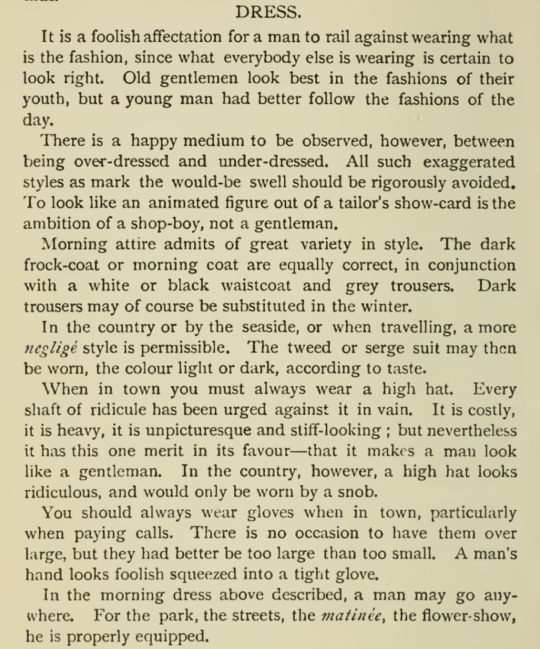
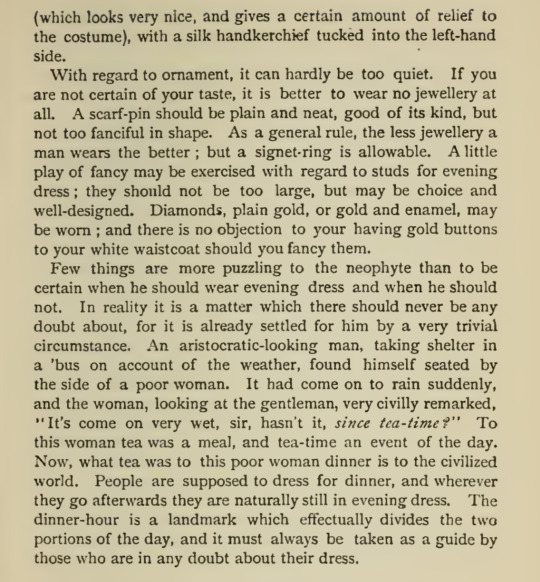
and excerpts from The Complete Bachelor: Manners for Men by Walter Germain, written in 1896:
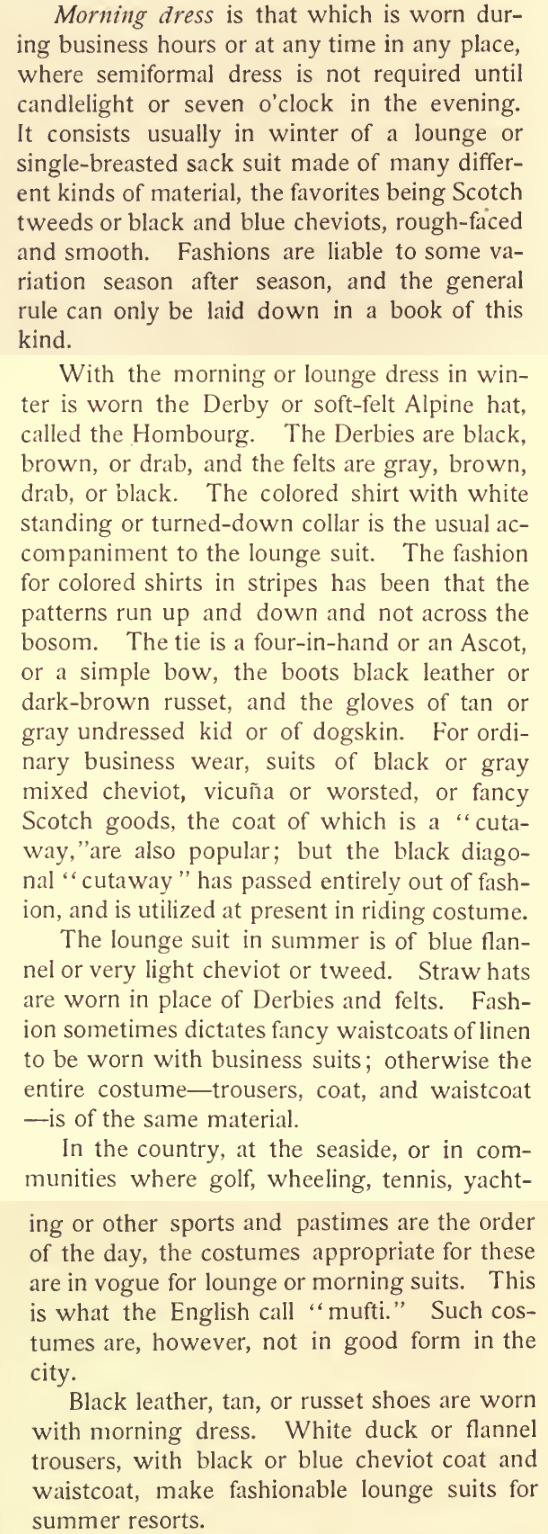

Cecil B. Hartley states in his Book of Etiquette and Manual of Politeness (1860) that "by dress we show our respect for society at large, or the persons with whom we are to mingle".
He advised men that there were “shades of being ‘dressed;’ and a man is called ‘little dressed,’ ‘well dressed,’ and ‘much dressed,’ not according to the quantity but the quality of his coverings.”
Black was "the" color. As Lydia Edwards writes in How to Read a Suit (2020), "while it is unrealistic to imagine that all men everywhere only wore black, the acceptable color palette was certainly more limited at this point than it had been for the first half of the century. The rising professional middle classes seemed to embrace a centuries-old association with black for certain professions, which perhaps made this an inevitable choice for the evolving and expanding world of work in the nineteenth century."
I'm going to add illustrations now; humbly request you ignore how terrible the paint canvases i threw things in. Things to note moving forward:
there were three different types of shirt collars in vogue at the time: stiff, high stand collars that hugged your neck, wing-tip collars, and one that's closer to the "regular" collars you typically see nowadays (banker collar). don't really see the last one in any of the fashion plates but you do see it in portraits.
Do note that walking sticks were commonplace and in fact expected to be touted around, hence why they (in addition to umbrellas) keep reappearing in the illustrations;



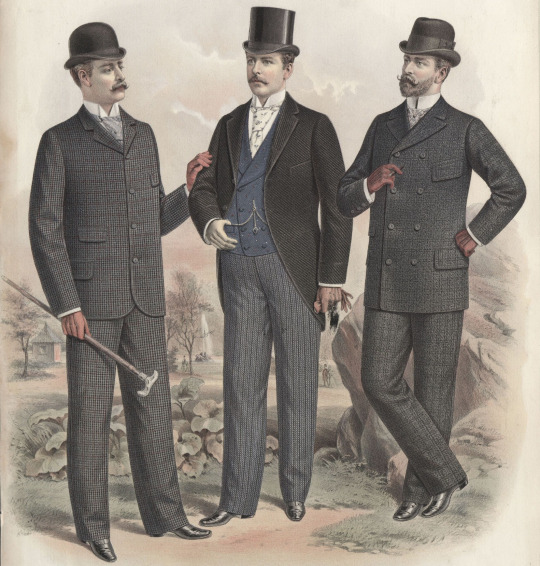
(1890)
Frock coats were the most "formal" of the daywear. When going through the National Portrait Gallery website you'll notice that most men are wearing either a morning coat or frock coat; the lounge coat was still too informal to be considered for how much money you'd spend to get a photograph taken. Don't you want to look nice?

Lounge suits, again, were the ultimate "informal"; they were viewed with distain by the frock-coat. (here's a good thread on this, actually; i love this fucking guy lol). really, really don't think Dio would be wearing one that often. maybe a double-breasted one? i really think he's too much of a snob to wear what he sees as filthy poor people rags. appearance is everything, etc.
~~~
waistcoats you have a lot of freedom/liberty with, at least in regard to design (except for evening waistcoats). different lapel shapes, no lapels... unfortunately shifting into the later decades of the 19th century it was pretty much expected that the fabric of your waistcoat match the fabric of your suit (along with your trousers; called a "ditto suit"). jonathan would conform to this mode IMO, i don't think it stops dio. he has a vision & his waistcoats are likely very extensively detailed. actually I just remembered that we do see one as depicted by araki's tenuous grasp of historical fashion and it is. awesome. i, too, love to wear cravats directly underneath my shirt


(1891 / 1892)
~~~
Evening dress is (comparatively) much more simple & men had much less artistic freedom in their choice of dress: black tailcoat, white gloves, white tie, waistcoat in either black or white, black button boots. Regardless, it was its own beast in the fact that this was something that you really weren't supposed to dick around with. (Dio would've found a way, but that's a discussion for a post that isn't crashing every 3 minutes.) From A Gentleman by Maurice Francis Egan (1893):
If a young man is invited to a dinner or to a great assembly in any large city, he must wear a black coat. A gray or colored coat worn after six o’clock in the evening, at any assembly where there are ladies, would imply either disrespect or ignorance on the part of the wearer. In most cities he is expected to wear the regulation evening dress, the “swallow-tail” coat of our grandfathers, and, of course, black trousers and a white tie. In London or New York or Chicago a man must follow this last custom or stay at home. He has his choice. The “swallow-tail” coat is worn after six o’clock in the evening, never earlier, in all English-speaking countries.
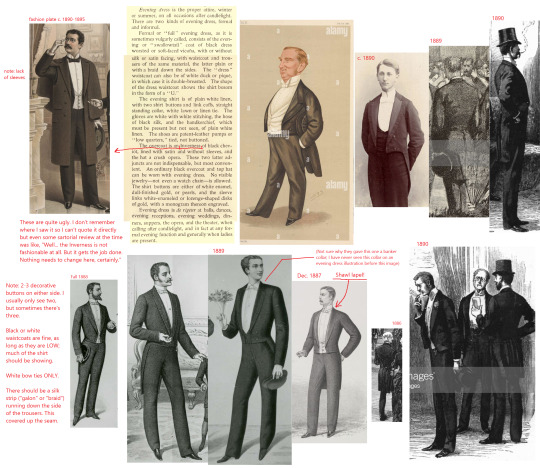
(1885 (misfiled) / 1888 / 1888 / 1890)



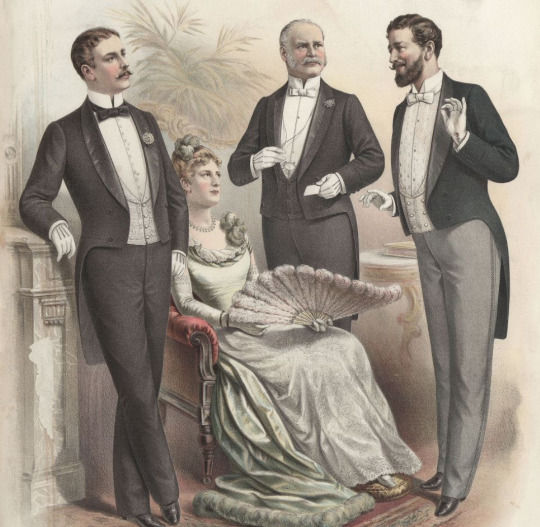
MET evening suit ca. 1888; different aspects of the ensemble displayed solo at this link.
In the 80s the "dinner jacket" ("tuxedo" in US) was introduced. It was used for more informal occasions.

final evening dress "tips":


~~~
Outerwear was pretty varied… you can get a pretty wide dynamic of form depending on choice of coat, so keep that in mind. chesterfields tended to be pretty formless, top frocks a bit more fitted. Length/density would change depending on season, too.

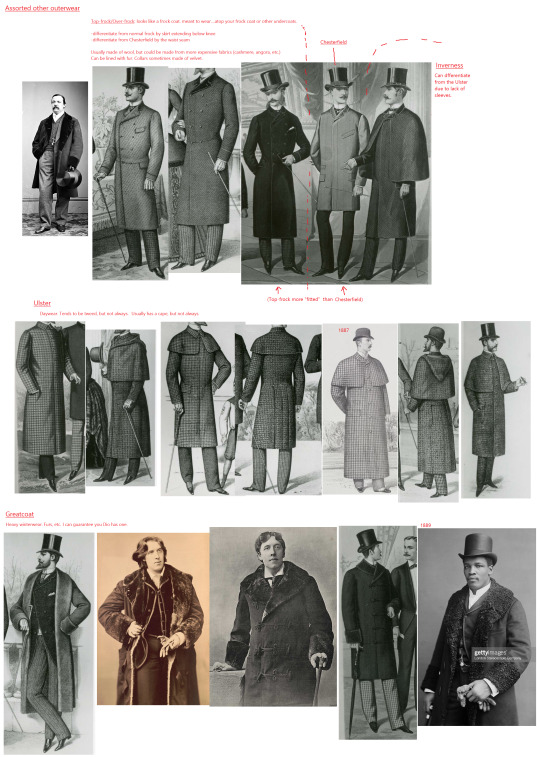
~~~
Children's fashion:


end notes:
everyone would be wearing suspenders, not belts; belts were pretty much only worn with military uniform at this time (except in america)
sweater vests were really only considered sportswear until the first few decades of the 1900s. they would not be wearing these casually under jackets, they'd be wearing waistcoats
button boots were buttoned using a special button hook. video demonstration
NOTE: trousers being "creased" began to be more in vogue in the 90s; this is because they finally invented the trouser press. read article for more information--you sometimes see creases in the 80s, really not before then though. look at how they bunch at the knee (c.1880s)!

When it comes to gloves, different colors denoted different occasions to wear them. In the text screenshots provided in previous sections, it usually states which colors are appropriate for whichever situation. The paragraph I am about to end this on is relatively useless, but I thought I'd include it anyway:

#ask#dio brando#jonathan joestar#phantom blood#I make myself sick going through fashion plates and the costume archives on museum websites identifying dio outfits regularly#that one image in the frock coat graphic reminds me so much of jeremy strong...kendall will get his day on ottiliere someday. but not today#I'll probably add to this post as I remember or discover more things to add. we're all on a journey of learning...together#posts that crashed one million times while editing#there was a lot more I wanted to add to this but every time i click something in here the entire post crashes. so i am leaving it#also FYI: i don't have a degree in this or nothing. I am a hobbyist victorian enthusiast. don't think anything is wrong in here especially#considering I cite sources but yaknow. <-disclaimer
61 notes
·
View notes
Text
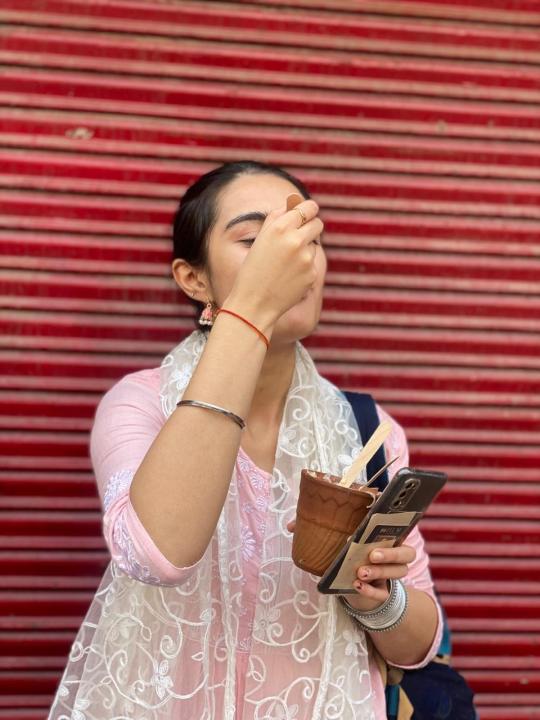

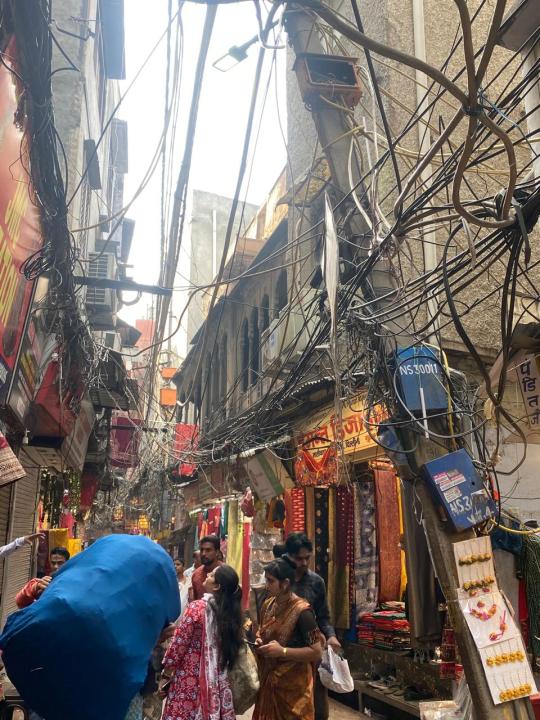

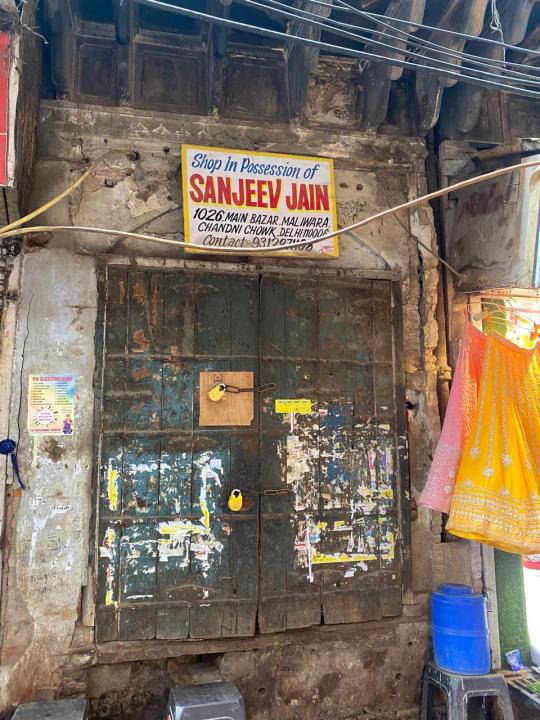

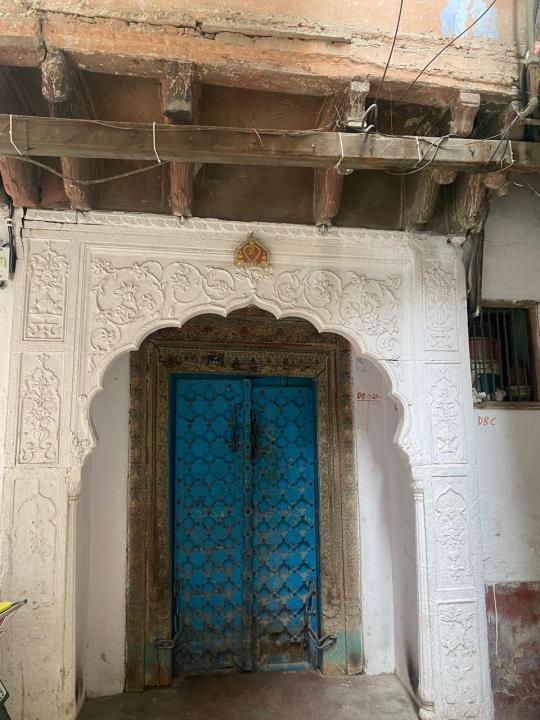
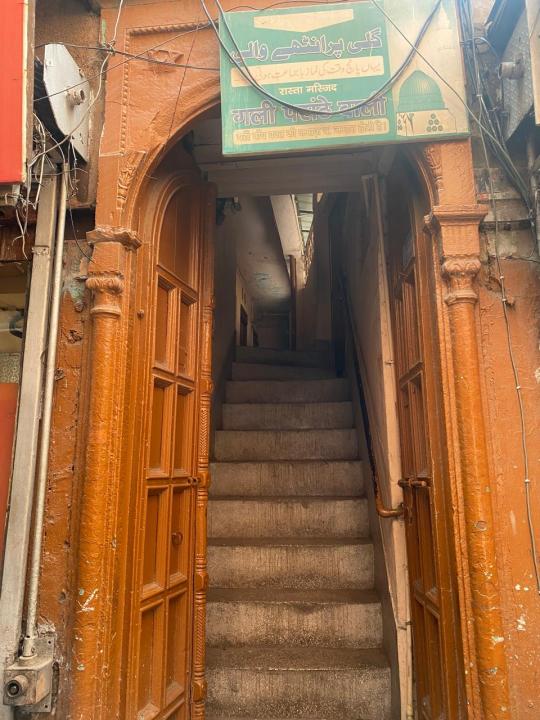
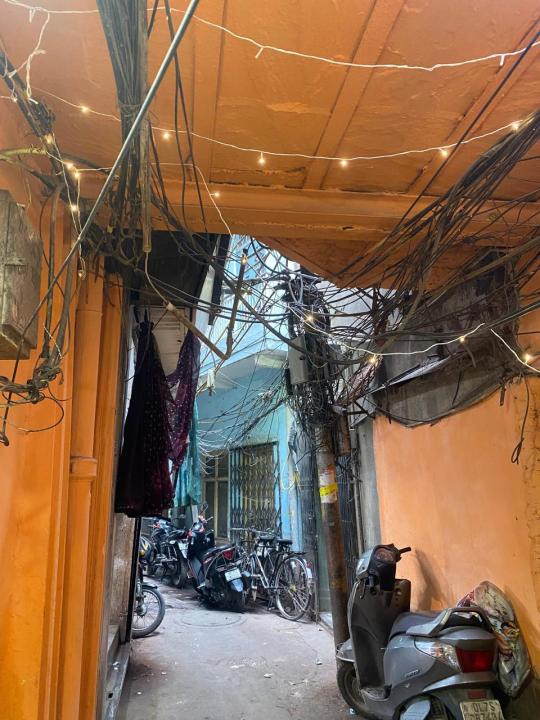
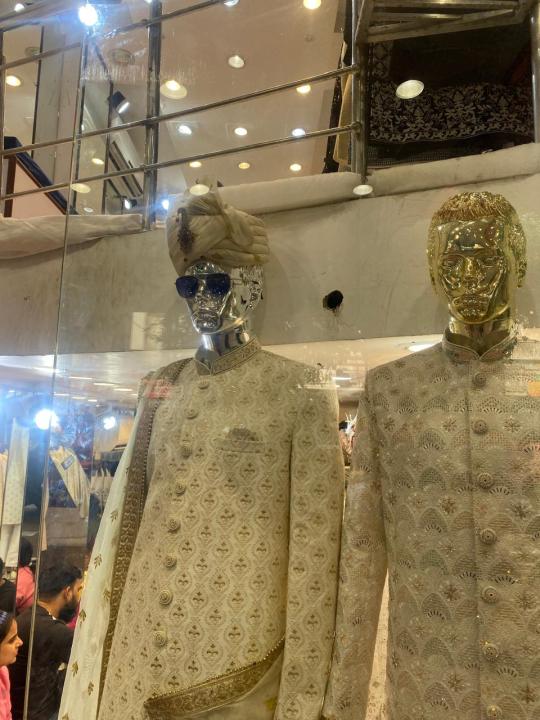
Chandni Chowk
Shopping in Chandi Chowk offers a staggering range of goodies ranging from books, clothes, electronics, shoes, leather and consumer goods. Walking along this jostling street can get quite intimidating, so be prepared to get stunned. Each area of Chandni Chowk has different markets, which are known for various things.
Nai Sadak
Nai Sadak is mainly known for books and stationery items. It is perfect for the students and bibliomaniacs who will find everything they need here, ranging from books for competitive exams to second-hand college textbooks, fiction novels and even Hindi fiction and non-fiction.
Dariba Kalan
Dariba Kalan is known for jewellery, especially silver and gold items. The highlight here is the availability of hand-crafted jewellery. The best part about shopping at this market is the cost of the items is usually around 25% less than the other markets. You will also find kundan and meenakari jewellery here, along with shops selling perfumes and oils.
Chawri Bazar
Chawri Bazar is your go-to place if you are looking to get wedding cards printed in bulk. It specialises in the sale of paper products. You will find all kinds of wedding cards here - simple and subtle to fancy and extravagant.
Kinari Bazar
Kinari Bazar is a haven for your wedding shopping. It is a narrow lane known for selling the best zardozi items such as laces and frills. Apart from this, you will also find Parsi borders, motifs, ribbon laces and all the embellishments for your wedding lehenga.
Bhagirath Palace
This is Asia's largest wholesale market for electrical and electronic items. Right from simple light fixtures to fancy decorative lamps, you will find everything you need to decorate your home. That too at dirt cheap prices!
Ballimaran Market
This market is known for selling shoes at affordable prices. There are all kinds of shoes available here, ranging from formal shoes to dress shoes. You will also find a lot of opticians here, though don't depend on their eye testing skills. You can find a huge variety of frames and sunglasses at a throwaway price.
Chor Bazaar
Chor Bazaar is one of the biggest thrift markets in the city and offers things like Books, clothes, shoes, gym equipment, camera, stationery and antiques, you name it, and they have it.
There are plenty of other markets in Chandi Chowk selling various knick-knacks:
Khari Baoli is a street dedicated to spices, nuts, herbs and dried fruits. Located at the western end of Chandni Chowk, there is no spice that you won't find here.
Fatehpuri Market is a wholesale trade market for khoya and paneer. You will also find plenty of eateries here.
Kucha Choudhary Market is also known as the photo market. You can get all types of cameras and its accessory at every corner of this market.
Katra Neel is the wholesale market for all kinds of clothes. The first franchise of Raymond from Old Delhi is also located here. There are plenty of shops selling sarees, lehenga, salwar suits and men's wear.
Moti Bazar is known for shawls in a myriad of design, colour, style and type of wool. It is called as the Moti Bazar as it specialises in the sale and purchase of pearls.
Nearest metro station - Chandni chowk
(P.C- INSHA RANA)
6 notes
·
View notes
Text
CARPET DEALER IN AGRA
We have been providing top-quality carpets to our valued customers for over a decade. Our extensive collection also includes soft and cozy lohis , barabanki, gamcha, shawls, dupattas, blankets, rajais, and comforters, ensuring that you stay warm and comfortable all year round. Whether you're looking to refresh your bedroom, add a pop of color to your living room, or transform your outdoor r, our expertly curated selection has something for every taste. We're your one-stop destination for both wholesale and retail needs! Visit us today at Shop no. 10, Subhash Bazar, Dalpat Singh Market, Agra
2 notes
·
View notes
Text
0 notes
Text
Creative Ways to Style and Customize Your Fashion Brooch
Fashion jewelry brooches have made a strong comeback inside the global of add-ons. Once taken into consideration antiques, they may be now the latest way to express personal style. Whether you put them on apparel, luggage, or maybe footwear, a well-located brooch can remodel any outfit. If you love particular fashion jewelry, right here are a few innovative ways to style and personalize your fashion brooch to make an announcement.

Unique Ways to Wear and Personalize Your Brooch
1. Style Your Brooch with Clothing
A style brooch can enhance any outfit, from casual to formal. Try these styling ideas:
Blazers and Jackets: Pin a brooch wholesale for your blazer lapel for a refined look.
Scarves and Shawls: Secure your scarf stylishly with a brooch instead of a knot.
Dresses and Tops: Place a fashion brooch on the neckline or waist to create a focal point.
Denim Jackets: Add a mix of brooches to a denim jacket for a playful, modern vibe.
Read Also: Top 5 Trends in Wholesale Rings You Can't Afford to Miss
2. Add a fashion jewelry Brooch to the Accessories
Brooches aren’t only for clothing; they can make your accessories stand out too.
Handbags: Attach a fashion brooch for your purse strap or front pocket for a custom contact.
Hats and Caps: Decorate a simple hat with an elegant brooch for a vintage or contemporary look.
Shoes: Clip a small brooch wholesale onto flats or heels for a unique fashion twist.
3. Use Brooches for Hair Styling
A brooch can also be a beautiful hair accessory.
Hairbands and Clips: Attach a fashion jewelry brooch to a plain hairband or clip for an elegant touch.
Bobby Pins: Pin a brooch to the facet of your updo or braid for additional shine.
Bun Decoration: Secure a brooch near your bun for a sophisticated appearance.
4. Customize your fashion Brooch for a Unique Look
If you purchase brooches from a brooch wholesale supplier, you can customize them in amusing approaches:
Add Pearls or Charms: Attach small pearls or charms for a personalized touch.
Mix and Match: Wear more than one brooch together to create a unique arrangement.
DIY Brooch Pins: Convert antique fashion jewelry into brooches by including pinbacks.
5. Fashion Brooches as Home Décor
Brooches can also be used beyond fashion to beautify your space.
Curtain Holders: Use brooches to pin back curtains stylishly.
Cushion Accents: Attach a brooch to decorative pillows for an elegant touch.
Wall Art: Arrange fashion brooches in a frame to create a unique art piece.
Read Also: Wholesale Gold Plated Chains – Stylish & Affordable at Kaash Jewelry
Final Thoughts
A style brooch wholesale is an elegant and flexible fashion jewelry piece that allows countless creativity. Whether you put on it traditionally or outside the box, a brooch can instantly upgrade your style. Try these ideas and experience making your brooch a signature piece for your dresser.
0 notes
Text
The Secret to Finding Premium Winter Scarves and Stoles: A Guide for Retailers
Winter is the season of style and warmth, and scarves play a crucial role in achieving both. Whether you’re a boutique owner or a retailer looking to stock up, understanding the intricacies of wholesale purchases is key. Let’s dive into the details of sourcing winter scarves, stoles, and ladies’ scarves, focusing on what matters most.
Why Wholesale Winter Scarves and Stoles Are a Retail Essential?
The demand for winter scarves peaks every year as temperatures drop. Global market trends show an annual increase of 6% in scarf sales during winter months, reflecting their growing popularity. Retailers who capitalize on this demand by purchasing from wholesale winter stole manufacturers often enjoy higher profit margins.
Winter scarves come in various materials like wool, acrylic, and blends. Wool remains a top choice for premium customers due to its insulation and timeless style, while acrylic options cater to budget-conscious buyers. When choosing a manufacturer or wholesaler, look for diverse designs, from classic plaids to trendy prints, ensuring you cater to all customer preferences.
Working with wholesalers in bulk allows you to secure competitive pricing and stay ahead of the competition. It's not just about selling scarves; it's about understanding the seasonal needs of your audience and aligning with them.
2. What Sets a Great Scarf Ladies Manufacturer Apart?
Not all scarf manufacturers are created equal. Finding the right Scarf Ladies manufacturer involves evaluating quality, design variety, and production ethics. With fast-changing fashion trends, ladies’ scarves need to blend elegance and utility seamlessly.
An excellent manufacturer will offer a catalog featuring vibrant colors, modern patterns, and premium fabrics. They will also provide options for bulk orders without compromising on design. This is crucial for meeting retail demand efficiently.
Moreover, ethical production has become a deciding factor for many buyers. Customers prefer scarves made with sustainable materials and processes. Collaborating with manufacturers who meet these standards boosts brand reputation and customer loyalty.
At English Creations Craze, we prioritize providing stylish, high-quality scarves while maintaining ethical manufacturing practices. Our diverse collection ensures your customers find something they’ll adore, whether it’s a lightweight stole or a cozy wool scarf.
3. Wholesale Winter Stole Manufacturers: A Hidden Gem for Retail Success
Stoles are the underrated champions of winter fashion. Their versatility allows them to transition from casual outings to formal events, making them a must-have accessory. Retailers who partner with wholesale winter stole manufacturers can tap into this demand effectively.
The best manufacturers offer customizable designs, enabling you to add unique touches to your collection. Consider stoles with embellishments like tassels, embroidery, or reversible prints for added appeal. Bulk buying from reliable manufacturers not only reduces costs but also ensures timely delivery during peak seasons.
For wholesalers, maintaining consistent quality is non-negotiable. A single defect can tarnish your reputation with retailers. Partner with manufacturers who conduct rigorous quality checks and use top-notch materials. This not only protects your brand but also guarantees customer satisfaction.
4. Tips to Buy Winter Scarves in Bulk Without Compromising Quality
Buying winter scarves in bulk is a cost-effective strategy, but it comes with its challenges. To ensure you get the best value, start by vetting your supplier. Look for transparent policies, clear pricing, and strong reviews from other buyers.
When placing bulk orders, prioritize versatile designs and neutral colors. These sell faster as they appeal to a broader audience. Don’t shy away from experimenting with a few bold patterns to attract niche customers.
Another critical factor is negotiating terms for returns or replacements. This ensures you’re covered if a batch doesn’t meet your expectations. A trusted partner, like English Creations Craze, makes bulk buying seamless by offering competitive rates, consistent quality, and a wide array of options tailored to your business needs.
5. How Wholesalers and Manufacturers Shape the Scarf Industry
The scarf industry thrives on collaboration between wholesalers and manufacturers. Wholesalers act as a bridge, connecting retailers with high-quality products at affordable rates. Manufacturers, on the other hand, bring innovation and expertise to the table.
For example, advanced weaving technologies now allow manufacturers to produce scarves that are both lightweight and warm, catering to modern consumer demands. By staying updated on these innovations, wholesalers ensure their clients have access to the latest trends.
As a retailer, choosing the right wholesaler is critical. Evaluate their inventory, customer service, and delivery timelines. The right partnership can elevate your business, ensuring you’re always stocked with the season’s best offerings.
Conclusion Understanding the dynamics of scarf manufacturing and wholesale processes is essential for retail success. By partnering with trusted names like English Creations Craze, you ensure your inventory reflects both quality and variety. Start stocking up on winter scarves and stoles today to meet your customers' needs and boost your profits.
Ready to make your next big purchase? Contact us now and experience excellence firsthand!
#accessories#bags#shawls#wholesale#silk scarves for women manufacturers#scarves#textiles#wholesale shawls
0 notes
Text
Things You Can Get From Nepal Handicraft Wholesalers!

Are you searching for Unique Nepalese products that will decorate your Home, your outfit, or your gift pool? Nepal has an excellent historical and cultural heritage and handicrafts that clearly express the artistic talent and ingenuity of concerned generations of art masters. In Nepal Handicraft Wholesaler, authentic and unique products are distinguished both in quality and artistry-for home decoration items, personal accessory items, and something in the middle. Now, let's find some surprising things from Nepal Handicraft Wholesaler.
Hand-Woven Fabrics
Handloom Nepal offers gorgeous fabrics of woven products like pashminas, shawls, and scarves, all made of wool, silk, and cotton. They possess the beautiful designs with fine textures and are best to use each day or a good gift item. Authentic high-quality products always are purchased through buying from Nepal Handicrafts Wholesale.
Traditonal Jewellery
Nepali jewelry is ornate in style and is influenced by nature and the spiritual. All necklaces, earrings, and bracelets are created from silver, brass, and semi-precious stones. Buying from Nepal Handicrafts Wholesale ensures that the artisans are well represented and will also enhance your variety of collection.
Handmade Home Decor
Decoration of your Place? These Nepalese handicrafts are surely meant for you-wrought-iron carvings, metal statues, prayer flags, Buddha statues, to name some. Traditional masks are an ideal decoration element for spiritual purposes and adding to your artistic flair. Get it from a
Nepal Handicraft Wholesaler is known to be pocket-friendly prices and authenticity guaranteed.
Green Products
Nepalese handicrafts include some environment-friendly products such as paper products made manually, bamboo crafts, and also bags made from natural fibers. The above sustainable products can be used for one's personal needs or even as a gift to someone. Therefore, buying from a Nepal Handicraft Wholesaler goes towards this environment-friendly production of products.
Conclusion
Nepalese handicrafts have a combination of culture, tradition, and creativity. You may be well aware of several products sold by any Nepal Handicraft Wholesaler, such as hand-woven textiles, traditional jewelry, handmade home decor, and eco-friendly raw materials. These precious pieces are written with different stories on the rich heritage of Nepal.
Want to get the best quality authentic Nepali art and craft? If yes, Nepal Handicraft Product Exporter P. Ltd is the leading manufacturer, wholesaler, and exporter of the best handicraft products from Nepal. Contact us at +977 1 5353677 or send an email via [email protected] or [email protected].
Resource: https://nepalhandicraftproductkathmandu.blogspot.com/2025/01/things-you-can-get-from-nepal.html
0 notes
Text
Latest Fashion Clothes for Ladies in India – Shop Trendy Styles with Labisa Fashion
Fashion in India is a dynamic industry, blending cultural heritage with contemporary trends. Whether it’s ethnic wear, casual styles, or Indo-Western outfits, Indian women’s fashion has something for every occasion. At Labisa Fashion, we specialize in manufacturing and supplying high-quality garments for bulk buyers, wholesalers, distributors, and stockists across India.
If you’re in the B2B fashion market looking for latest fashion clothes for ladies in India at competitive wholesale prices, this guide will walk you through the most in-demand styles and trends dominating the industry.
Understanding Women’s Fashion Trends in India
Traditional vs. Modern Trends
Indian women have a vast wardrobe selection, ranging from traditional sarees and salwar suits to modern gowns and fusion outfits. While traditional attire remains a stronghold in festive and wedding fashion, contemporary designs like co-ord sets and asymmetrical kurtis are becoming mainstream. Stocking both ethnic and modern outfits ensures a well-balanced collection that appeals to a broader customer base.
Influence of Bollywood and Social Media on Fashion
Fashion trends in India are heavily influenced by Bollywood celebrities and digital influencers. Whether it’s a trending Indian ethnic wear for women worn by a famous actress or a viral Indo-Western ensemble showcased by Instagram influencers, the demand for stylish and up-to-date fashion is at an all-time high. Retailers and distributors must stay updated with these trends to attract modern consumers.
Popular Fabric Choices for Women’s Clothing in India
Cotton, Silk, and Georgette – Comfort Meets Elegance
The Indian climate plays a significant role in fabric selection. Cotton remains the top choice for daily wear due to its breathability, while silk and georgette are widely preferred for festive and formal occasions. Manufacturers offering a variety of fabrics cater to a more diverse clientele, increasing their market appeal.
Sustainable and Eco-Friendly Fabrics Gaining Popularity
With a growing awareness of sustainability, there is increasing demand for eco-friendly fabrics such as organic cotton and bamboo silk. Retailers and stockists can gain a competitive edge by incorporating sustainable fashion into their inventory.
Seasonal Fashion Trends for Indian Women
Summer Styles: Breezy Dresses and Kurtis
During the warmer months, lightweight fabrics, flowy silhouettes, and pastel shades dominate the market. Straight-cut kurtis, cotton palazzos, and floral dresses are some of the best-selling styles. Explore our Best Straight Kurtis Collections for a curated selection of trendy summer outfits.
Winter Fashion: Layering with Elegance
Winter fashion in India involves layering stylishly with woolen shawls, jackets over kurtis, and velvet suits. Wholesalers should invest in warm yet fashionable clothing to meet seasonal demands.
Ethnic Wear Trends for Indian Women
Sarees – Timeless Beauty with Modern Twists
Sarees continue to be a wardrobe staple, but modern designs such as pre-stitched drapes and ruffled sarees are gaining traction. Adding innovative ethnic designs to your stock can significantly boost sales.
Lehengas and Anarkalis – The Festive Glamour
For weddings and festivals, nothing beats the charm of a well-crafted lehenga or Anarkali. As an Anar kali Manufacturer, Labisa Fashion offers a stunning variety of Anarkalis that blend elegance with contemporary aesthetics.
Western Wear Trends for Women in India
Dresses, Jumpsuits, and Chic Co-ord Sets
Western fashion has seen massive growth in India, with dresses, jumpsuits, and stylish co-ord sets becoming wardrobe essentials. Wholesalers can capitalize on these trends by offering diverse color palettes and prints.
Casual Fashion: Denims, Tops, and Sneakers
Casual fashion is all about comfort and style. Denims, oversized tops, and sneakers are in high demand, particularly among younger demographics.
Fusion Fashion – The Perfect Blend of Ethnic and Western Wear
Indo-Western Dresses for Office and Parties
Indo-Western outfits, such as tunic dresses and dhoti pants with crop tops, are making waves in the Indian fashion market. If you're looking for a reliable Indo-western supplier in India, Labisa Fashion offers a wide range of stylish fusion wear for bulk buyers.
Statement Accessories to Complete the Look
Accessories like oxidized jewelry, embroidered handbags, and ethnic footwear enhance any Indo-Western outfit. Businesses can increase revenue by offering complementary accessories alongside apparel.
Workwear Fashion for Indian Women
Formal Wear Trends: Sarees, Pantsuits, and Blazers
The demand for workwear fashion is rising, with women opting for sleek sarees, structured pantsuits, and blazers for professional settings. Wholesale businesses catering to office wear trends can tap into a growing segment.
Business Casuals – The Smart and Comfortable Look
Comfortable yet stylish business casuals, including straight kurtis and palazzos, are popular choices. Our Best plazo for women collection is ideal for businesses looking to stock up on versatile and elegant workwear essentials.
Party Wear Trends for Women in India
Shimmer, Sequins, and Gowns – Red Carpet Inspired Looks
Party wear trends in India include shimmering sarees, sequined gowns, and embellished anarkalis. Stocking statement pieces that reflect red-carpet glamour can attract high-end customers.
Cocktail Dresses and Ethnic Gowns
For special events, Indo-Western gowns with intricate embroidery are highly sought after. Offering a mix of cocktail dresses and ethnic gowns ensures a well-rounded party-wear collection.
Affordable Fashion – Budget Shopping Tips for Retailers
Best Online Stores to Buy Trendy Fashion
Wholesale buyers need reliable suppliers offering quality at the best prices. Labisa Fashion is a trusted name in the industry, delivering top-notch styles with a commitment to affordability.
Smart Shopping – Mix and Match for Versatile Outfits
Retailers can maximize sales by curating collections that allow customers to mix and match garments for multiple styling options.
Why Choose Labisa Fashion for Wholesale Women’s Clothing?
Labisa Fashion is a leading manufacturer and supplier of premium women’s garments in India. We offer a wide range of ethnic, casual, and Indo-Western wear at unbeatable wholesale prices. With a strong reputation in the industry, we are the preferred choice for bulk buyers, distributors, wholesalers, and stockists looking for quality fashion at competitive rates.
Get in Touch
If you are a wholesaler, distributor, or bulk buyer, partner with Labisa Fashion to stock the latest and trendiest women’s apparel.
📍 Address: Sion West, Dharavi, Mumbai, Mumbai 400017 📞 Afzal: +91 98929 39564 | Labisa Sales: +91 81699 85975 📧 Email: [email protected], [email protected]
Visit Labisa Fashion today and explore our premium collections at the best wholesale prices!
0 notes
Text
Embrace the Warmth: A Wool Scarf Lover's Guide
As the winter winds howl and temperatures plummet, there's no better way to stay cozy and stylish than with a luxurious wool scarf. This timeless accessory offers a blend of warmth, comfort, and versatility that's unmatched. Let's delve into the world of wool scarves and discover why they're a must-have for every winter wardrobe.
The Irresistible Allure of Wool Scarves A Symphony of Warmth: Wool's natural insulating properties make it the perfect fabric to combat the winter chill. Wrap yourself in the comforting embrace of a wool scarf and experience unparalleled warmth. A Canvas for Style: Wool scarves come in a myriad of styles, colors, and patterns, allowing you to express your personal style and complement any outfit. From classic cables to intricate fair isle designs, there's a wool scarf to suit every taste. Versatility at Its Finest: Wool scarves are more than just neck accessories. Experiment with different styling techniques, from wrapping them around your neck to using them as shawls or headbands. A Touch of Luxury: Indulge in the luxury of a high-quality wool scarf. The soft, plush texture against your skin is a true indulgence. A Sustainable Choice: Wool is a renewable resource, making it an eco-friendly option for your winter wardrobe. Choose sustainably sourced wool to support ethical practices and reduce your environmental impact. Styling Tips for Wool Scarves Layer with Perfection: Wool scarves are the perfect layering piece. Pair them with coats, jackets, or sweaters for added warmth and style. Color Coordination: Choose a scarf that complements your outfit's color palette. For a bold statement, opt for a contrasting color. Experiment with Knots: There are countless ways to tie a wool scarf. Try different knots to find your favorite and add a personal touch to your look. Casual Chic or Formal Flair: Wool scarves are versatile enough to elevate both casual and formal outfits. Pair a chunky knit scarf with jeans and a sweater for a relaxed look, or drape a more refined scarf over a tailored suit for a sophisticated touch. Caring for Your Wool Scarf Hand Wash or Delicate Cycle: To maintain the quality and softness of your wool scarf, opt for hand washing or a gentle cycle on your washing machine. Avoid Harsh Detergents: Use a mild detergent specifically formulated for delicate fabrics to prevent damage. Air Dry: Lay your scarf flat to air dry. Avoid using a dryer, as the heat can shrink or damage the wool. Store Properly: When storing your scarf for the off-season, fold it neatly and place it in a breathable fabric bag to prevent wrinkles. By embracing the warmth, versatility, and style of wool scarves, you'll elevate your winter wardrobe and stay cozy in the most fashionable way. So, bundle up and enjoy the luxurious experience of a well-chosen wool scarf.
#shawls#pashmina#wholesale#cashmere#accessories#fashion#wool pashmina#wool shawl#wool scarf#wholesale suppliers#wholesale scarves
1 note
·
View note
Text


10’x12’ beautiful handmade shawl design Oushak #10x12 #oushakrug #handmade #washable #available #dc #soft #freeshipping #bulk #wholesale #firsthand #direct #nomiddleman #turkish #rug #unique #luxury #red #return #accept #red #upgrade #rugwashing #repair #quality #warehouse #bulk #sale
0 notes
Text

Autumn Winter Printed Cashmere Scarf Poncho Women’s Shawl
0 notes